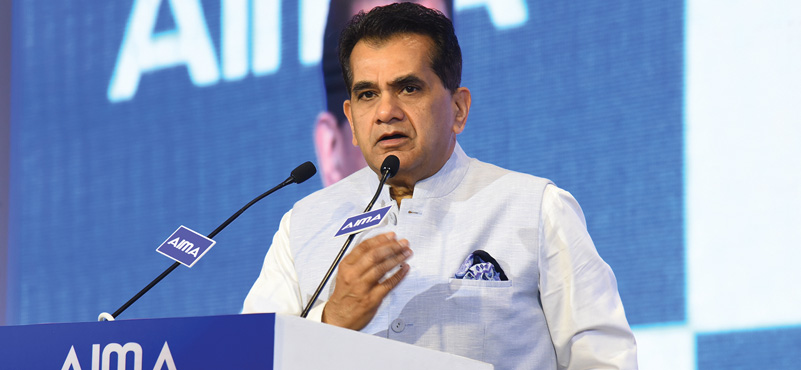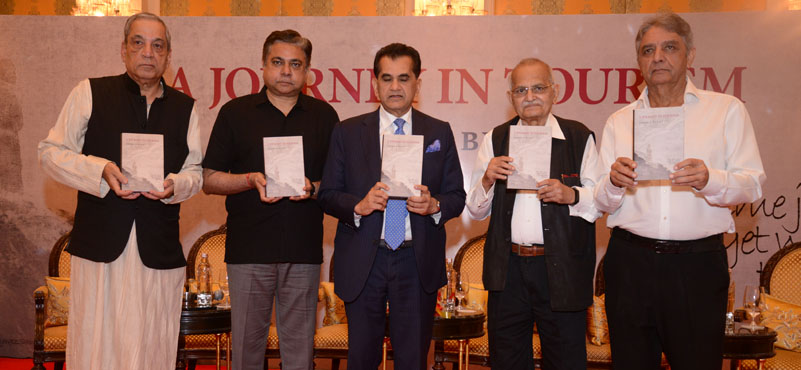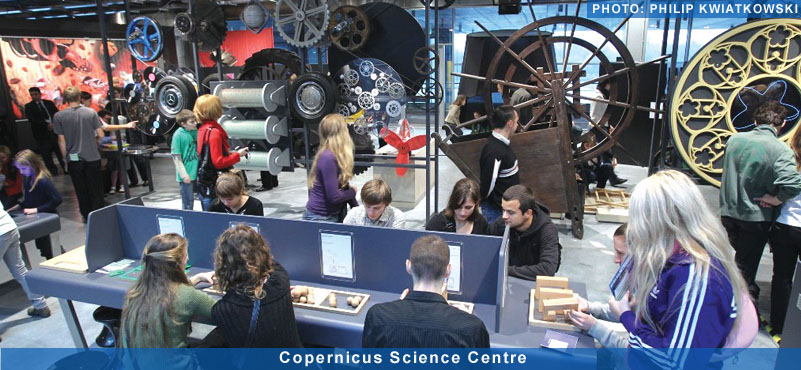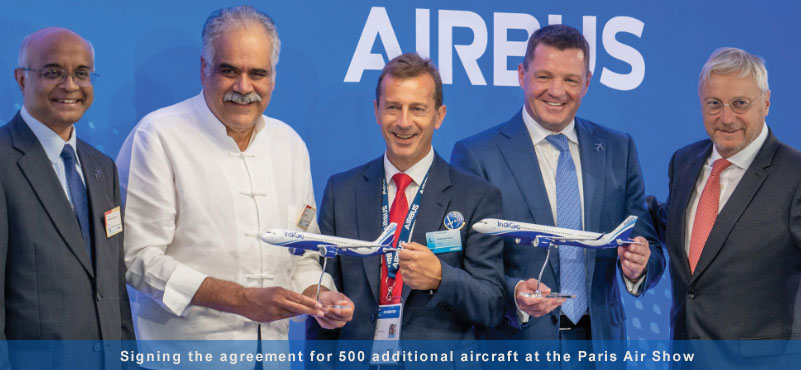In this conversation, India’s G20 Sherpa at the recent AIMA Annual Conclave in New Delhi, highlights the priorities that India has set as the agenda for the year long deliberations under her Presidency. Presented are the highlights from his address:
To my mind there are three critical components that are important. The first is the political leadership and the political narrative that India builds for the G20 and that is important because essentially it is a leaders’ summit. Prime Minister Modi is the leader of the G20 during the course of the year and therefore the developmental perspective of India is critical.
The second is the content and the priorities that India built up. What is India’s priority? How does it want to drive the global economy? How does it want to drive the world in future? The third is how well do we do the G20 presidency? How well do we execute it?
The first and foremost is the political narrative which is being conducted in a lively, vibrant democracy like India – the political narrative is that you have a leader who is driving the global G20 leadership, a leader who has very strong acceptance in a vibrant democracy. But I think more important than that is the development story that India has built up – that we are a young country which has young demographics, our average age is 29 and even as we go on to 2070 our average age will still be about 35. And that we have truly driven the digital transformation of India.
That we are a country which has ensured a digital identity for every Indian. We have ensured that we open a bank account for every Indian. That we are able to link that bank account with Aadhar, his digital identity and the mobile number and ensure that everybody has his digital identity and the mobile number and that everybody can then use the mobile to make digital payments. And we do today 11x more payments than what the United States and Europe do together and we do 4x more payments than what China does. And therefore, it is a remarkable story of digital transformation.
 It is also a story that we have used open source, open API’s interoperable technology because if you look at the history of the open API’s interoperable technology, because if you look at the history of the world in the last two and a half decades all technological development world and innovation have been driven by the big tech. If they have been driven by Google, Microsoft, Apple, Amazon in the West, they have been driven by Tencent and Alibaba in China.
It is also a story that we have used open source, open API’s interoperable technology because if you look at the history of the open API’s interoperable technology, because if you look at the history of the world in the last two and a half decades all technological development world and innovation have been driven by the big tech. If they have been driven by Google, Microsoft, Apple, Amazon in the West, they have been driven by Tencent and Alibaba in China.
India took a different approach from other markets where it created the public platform, on top of which we have allowed private sector to innovate and compete in the market space.
So, if you look at UPI, we have connected over 500 banks with each other but we have allowed PayTM to compete with Google Pay, Phone Pay competes with Amazon, with Apple, everyone in the market place and there are 40 different companies competing as far as payments is concerned. And that has allowed a huge amount of innovation to take place. And what it has led to is an open source, open API model with the digital identity has ensured that a company like JIO, when it launched its mobile phone, was able to do an acquisition of over 200 million people in 100 days. The cost of acquisition of a customer which is about $25 before had shrunk down to $1. The cost of acquisition in Europe is still about $175 to $180. Why I am saying this is that we have done innovation to population scale at low cost. And that is important.
When I was a young officer in Kerala, my job, one of my jobs was to transform the lives of traditional fishermen. And we were able then to give them outboard motors, they could go much further into the sea. They could, we could give them new fiberglass graphs, we could give them new technology in terms of new fishing nets and introduce beach level auctioning. But fishermen were prone to drinking. And therefore, it was very important to open their bank account so they could save for a bad day when they will not get a catch. But opening a bank account was a nightmare. I used to chase bank managers nine months to open a bank account. The digital identity was a problem. Today, we open a bank account in India using biometric in less than a minute. So, I have seen this journey of transformation from nine months to less than a minute in India. And therefore, my belief is that the digital transformation that India has done during the COVID period, we were able to provide money into the bank accounts of 800 million people directly into the bank account without any leakages. And what the Bank of International Settlement said that India has achieved in seven years what it would have taken 50 years to achieve. So that the transformational story of India is immense – many of us do not realize it because we are seeing it on our day-to-day basis.
The other important story is also to tell you the story of the transformation in terms of development because India has been able to provide close to about 30 million houses. Now 30 million houses really means that we have provided a house to almost every single citizen of Australia. We have provided about 110 million toilets in India which is like providing a toilet to every citizen of Germany. We provided 243 million people piped water in the last five years – 243 million piped connection means that we provided water to every single person in Brazil, that is the size of Brazil. And we built 55,000 kilometres of road, that is like one and a half times the diameter of the earth. During the COVID period, we provided 2.2 billion people vaccinations which is totally paperless and cashless. And therefore, my view is that this developmental perspective of India is to be highlighted very strongly during the G20 presidency.
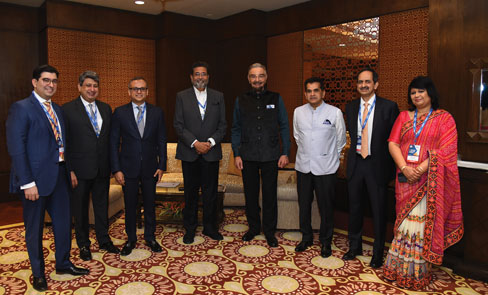
The second key critical component to my mind is what are the priorities before the world and what are India’s priorities? The first and foremost is that at a point of time when there is a global slowdown, it is very important to push for inclusive, resilient and sustainable growth, because without growth you will not be able to transform lives of citizens across the world. And when leaders of the world meet, it is very important for them to look at the lives of citizens and therefore how you achieve sustained growth on a long period of time to transform lives is very critical. And this is important because as I said, we are midway between the 2030 goal of sustainable development goals. Instead of progressing, we have regressed, we have fallen back, the world has fallen back from what it has said that it will transform lives of citizens through the sustainable development goals.
Now if COVID has impacted lives, inflation has impacted life, the progress made in the last 20 years, the world has lifted people above the poverty line through free trade. Instead, it has in the last three years, people have gone below the poverty line and therefore how do you accelerate the pace of growth is critical, how do you build up a new action plan for pace of growth is critical and how do you build up a new action plan for sustainable development goals which will enable you to actually accelerate sustainable development goals.
The third very critical issue is about climate action and climate finance because as we are all aware, the developed world, when they were industrialized, in the process they have carbonized the world, 88% of the total carbon space available; that is, out of 2,800 gigatons of carbon space available at 1.5 degree centigrade, some 2,400 gigatons has already been occupied by the developed world. India has occupied only 1.5% of the total carbon space available with 52 gigatons, though logically as per our population we are entitled to about 17.5% of the total carbon space available. And as we take this onward march for the next three decades of consistent rates of growth and as we urbanize, we will risk becoming a major polluter. And therefore, India’s challenge is to become the first country in the world to industrialize without carbonizing. And my belief is that this is important because the future belongs to those who digitize and those who go green. And countries and companies which go green will attract value and they will attract capital in due course. And therefore, it is very important that India adopts a very clean approach and a green growth approach. We have achieved our NDC targets committed at COP 21 in Paris, nine years ahead of schedule. We do about 172 gigawatts of renewable energy and we have now launched the green hydrogen mission. India is climatically blessed. India’s entrepreneurship is top class. We have the possibility of becoming the lowest cost producer, and the lowest cost exporter in the world will head towards green hydrogen.
The challenges about availability of low-cost financing is our ability to get 30 years financing at low cost. There is no shortage of money in the world. The world is flushed with resources but they are not able to fund money into emerging markets, whereas the risk profile of India is different. The interest rates in the United States are one and a half percent. The interest rates in India are about 8%. The interest rates in Africa are about 15% and in sub-Saharan regions they are 22%. And therefore, African sub-Saharan countries find it difficult to attract money. The challenge is how do we get 30 years financing in dollar terms at 1% or 2%?
Once emerging markets get long-term financing, they will become the champions of climate action and climate change. Without that India’s Indian entrepreneurs will find it very difficult to do long-term financing. And therefore, India’s fourth key priority is that there must be huge transformation in the multilateral financial institutions.
And the fifth priority is about digital transformation. But it is important to understand that in the world today, there are 4 billion people without a digital identity. There are 133 countries in the world who do not have a digital fast payment. Now India has been able to transform the lives of its citizens, become a more productively efficient economy because of digitization. And therefore, how do we take this model of India to the rest of the world is the challenge. And we will use the G20 narrative to push this digital transformation story of India to the rest of the world and see how we can use this opportunity to transform the lives of citizens in the global south. And that is what is important.
The last priority which the Prime Minister has put forth is women led development. That is important because today in India there are more women, which many of us are not aware; the new NFHS service says that there are 1,022 women to 1,000 men. Like in India and like in the rest of the world, it is not possible to go sustainably, till we are not able to put women into positions of leadership, we are not able to do more financial inclusion, we are not able to improve learning outcomes and health outcomes of women, we are not able to change the whole cycle of malnutrition by ensuring that women produce healthy children.
The India G20 is very different from what other countries do. Other countries hold G20 in one or two cities in their country. But the Prime Minister decided that he will use this opportunity to make this into a people’s movement. He will convert this into a Jan Andalon and take this G20 actually to every state of India. So, we are doing 215 meetings in all the states and union territories of India. We are conducting it in 59 cities of India. We are using this opportunity to transform every single city of India where we are taking it, in terms of the drainage, sewage, solid waste in terms of improving the quality of urban infrastructure. So, when we had the Sherpa meeting in Udaipur, the Fathegarh Lake was transformed, the roads were done up. We have just finished a meeting in Kumarakom in the backwaters of Kerala – an opposition run state. But it is a great example of cooperative federalism. They transformed the backwaters, they built up a new convention centre which will make Kumarakom a 365 days a year destination. They brought in houseboats, they really transformed the roads. So Kumarakom has become one of the top destinations and actually Aurangabad, Pune, all these cities have been transformed simply because of G20.
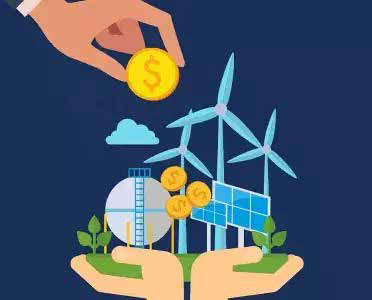 The other thing we are doing is to use this power to the G20 to push the brand entity of the states in terms of their culture. So everywhere we are promoting only the local state culture.
The other thing we are doing is to use this power to the G20 to push the brand entity of the states in terms of their culture. So everywhere we are promoting only the local state culture.
We are using this opportunity to push for millets in a big way. So, every meal has a millet component to it. We have done everything possible to bring a unique brand entity for every single state of India.
My belief is that G20 is a unique opportunity. It is an opportunity to brand, promote and market India, but more than that it is an opportunity to drive the destiny of the world through our leader. It is an opportunity to push for priorities which will be transformational for the world.
We are differentiating G20 from anything else. If you look, a football tournament is for 14 days, a cricket tournament is for about 20 days, a tennis tournament for 10 days, but here is G20 being done for an entire year and this is an opportunity to transform India and transform these 59 cities, and use this opportunity to transform the world which we will do to the best of our ability.
ABOUT THE AUTHOR
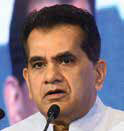 Amitabh Kant is presently India’s Sherpa to G20 group, during a year when India holds its presidency, and 2023 will witness over 200 meetings, in some 50 cities across the country, including the summit later in September. Kant is formerly a secretary in the Government of India, former CEO of Niti Ayog, and creator of globally acclaimed campaigns like ‘Incredible India’ for the Ministry of Tourism.
Amitabh Kant is presently India’s Sherpa to G20 group, during a year when India holds its presidency, and 2023 will witness over 200 meetings, in some 50 cities across the country, including the summit later in September. Kant is formerly a secretary in the Government of India, former CEO of Niti Ayog, and creator of globally acclaimed campaigns like ‘Incredible India’ for the Ministry of Tourism.

